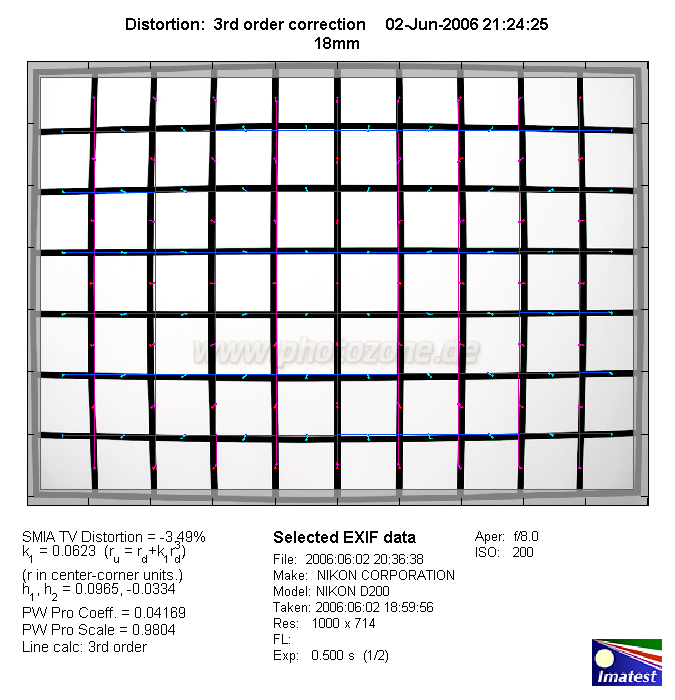|
Nikkor AF-S 18-70mm f/3.5-4.5 G IF-ED DX - Review / Test Report - Analysis |
|
Lens Reviews -
Nikon / Nikkor (APS-C)
|
|
Page 2 of 3
Distortion
Low distortion was obviously not a design objective for the AF-S 18-70mm DX - at least at the 18mm
setting where the lens produces very high barrel distortion (3.5%). However, the problem
eases rapidly when zooming out - at 24mm there's only a moderate degree of barrel distortion (1%)
changing to slight to moderate pincushion distortion towards the long end of the zoom range.
|
Move the mouse cursor over the focal length text marks below to observe the respective distortions
|
| 18mm |
24mm |
40mm |
70mm |
|

|
The chart above has a real-world size of about 120x80cm.
Vignetting
Besides high barrel distortions the lens has also a 2nd weakness - vignetting at 18mm @ f/3.5.
At 1.6EV is exceeds the usual scale of the graph in this section. Unless you correct the issue
via an imaging application this problem will be visible in many scenes (see also the 18mm f/3.5
sample shot below). However, for most users this will be a phantom pain because you rarely tend
to shoot at max. aperture at this setting. Nonetheless it is worth to mention that there's still
1EV vignetting left even at 18mm f/5. Beyond the problem is largely reduced and usually not
field relevant anymore. Same goes for the vignetting figures at 24mm and 40mm. Unfortunately
the vignetting increases again at 70mm where it exceeds 1.1EV again at f/4.5. Stopping down
to f/5.6 may be advisable in critical situations here as well.

MTF (resolution)
The Nikkor AF-S 18-70mm DX produced very good resolution figures under lab conditions.
At 18mm it is even pretty much comparable to the AF-S 17-55mm DX (@ 17mm) at the same
aperture settings and unlike the pro grade lens the AF-S 18-70mm DX produces only
a very moderate degree of field curvature at this setting. At wide-open aperture contrast
suffers a little though.
The lens has a slight weakness at 24mm at wide-open aperture where the drop in border
performance is somewhat more pronounced. Stopping down to f/5.6 improves the quality
significantly and the peak performance is reached at f/8 with a very good to excellent
resolution.
At 40mm and 70mm the center quality remains excellent followed by very good borders.
The lens suffers from slight residual aberrations (focus shift when stopping down).
Please note that the MTF results are not directly comparable across the different systems!
Below is a simplified summary of the formal findings. The chart shows line widths per picture height (LW/PH) which can be taken as a measure for sharpness.
If you want to know more about the MTF50 figures you may check out the corresponding Imatest Explanations
Chromatic Aberrations (CAs)
Lateral chromatic aberrations (color shadows at harsh contrast transitions) remain
well below 1px on the average at the image borders and should not be a big issue
under field conditions. The sample shots didn't show any significant signs of
purple fringing. Overall a quite impressive performance for a consumer standard
zoom here.

|